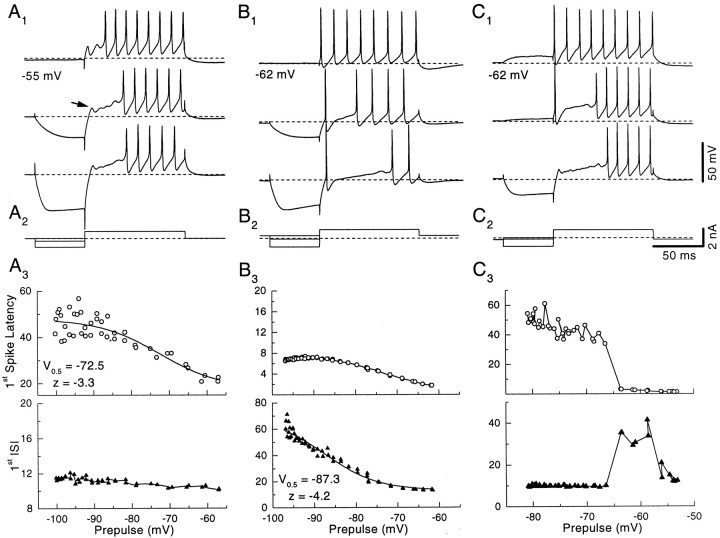Fig. 2.
Discharge patterns of rat DCN pyramidal cells and voltage dependence of first spike latency and first interspike intervals. A1, Superimposed responses to a constant depolarizing current step after a 50 msec hyperpolarization to different levels. The current injection protocol is shown in A2; the dashed line indicates the zero current level. An arrowpoints to subthreshold events.A3, The first spike latency (open circles) increases with increasing hyperpolarization between −60 and −90 mV, whereas the first interspike interval (filled triangles) is nearly constant. This cell shows the buildup discharge pattern. Theline through the first spike latency data is a Boltzmann fit, with the half-inactivation parameters shown.B1,B2, Another cell showing a short latency first spike and long first interspike intervals (pauser).B3, The first interspike interval (filled triangles) increases as the amplitude of the prehyperpolarizing pulse increases; the data are fit with a Boltzmann function, with the half-inactivation parameters shown. The first spike latency (open circles) shows a slight increase with prehyperpolarization according to the additional time needed to charge the membrane.C1,C2, Another cell showing a transition from chopper to pauser to buildup pattern.C3, As the amplitude of the prehyperpolarizing pulse increases from a depolarized level to −65 mV, the first interspike interval (filled triangles) increases, changing the firing pattern from chopper to pauser. At this point a further increase in prehyperpolarization causes the disappearance of the short latency onset spike and thus an increase in first spike latency to a value that corresponds to the sum of first spike latency and first interspike interval before the shift. The first interspike interval is reduced to the value of the subsequent interspike intervals. The cell is now a buildup. Stronger hyperpolarization further increases the first spike latency.

